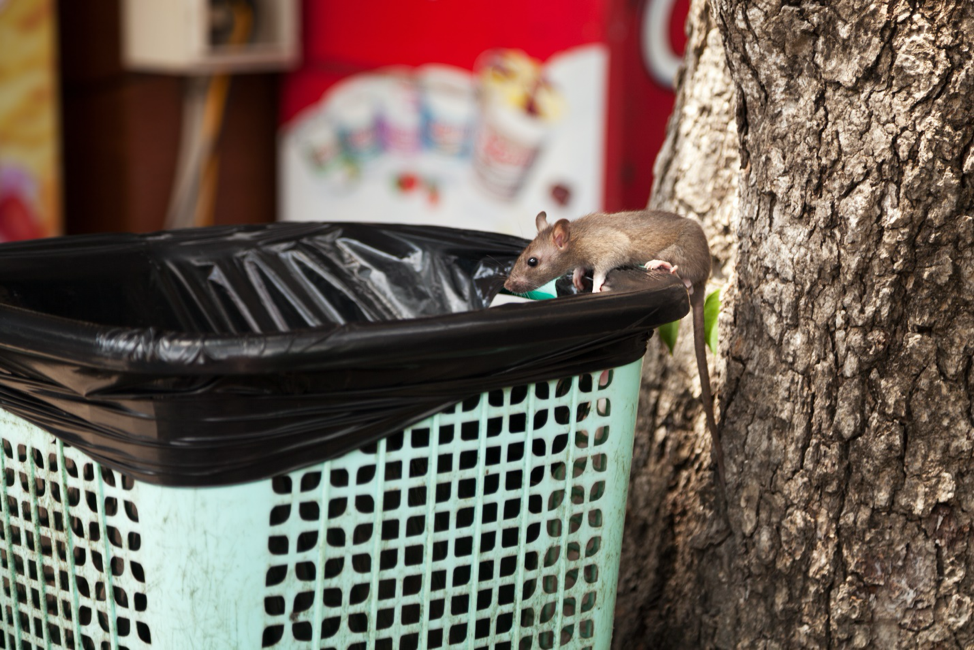
Rats are common rodents in Hawaii that infest homes across Oahu year-round. If you’ve ever had to deal with rats, you know how stressful an infestation can be. Unlike common house mice, rats are larger and much more destructive. Rats can be a headache for homeowners and commercial property owners alike. They can destroy food in your home and chew wires. This can lead to possible fire hazards, electrical malfunctions, and power outages. What’s worse, an opening doesn’t have to be large for the opportunistic rat to take advantage of. By using their strong teeth, rats gnaw small openings and holes to widen them for easy access, destroying your house in the process. As they move about your home, rats constantly urinate and leave behind especially large, toxic droppings. Mice are a big problem when it comes to infestations, but rats are arguably worse. They are incredibly smart and difficult to get rid of once they choose to call your home theirs.
What kinds of rats live in Oahu?
Rodents of all kinds live across Oahu. The most common type of rat that you’ll encounter in our area are Polynesian rats, Norway rats, and roof rats.
Polynesian Rats
The Polynesian or Pacific rat is the smallest rodent species found in Hawaii. These rats are typically under five-inches long and weigh 2-3 ounes. They’re easy to recognize with their large, round ears and their pointed snouts. They can have black or brown fur. Known as a field rat, you are more apt to see them making nests in rock piles, gulches, wastelands, and grassy mounds. Human made structures aren’t typically susceptible to Polynesian rat damage and activity, but that doesn’t mean it’s impossible. Usually, they are more of an agricultural nuisance, attacking various fruit and vegetable crops such as pineapples, coffee, coconuts, and macadamia nuts.
Norway Rats
Norway rats are especially large rodents, measuring 7-9.5” long with brown and black fur. When Norway rats live within homes and commercial buildings, they typically nest on the lower levels but if the population is too large, they may be found in the attic and ceiling areas. Their nests are built from soft material like paper or grass chewed into small pieces they gather from surrounding areas. Did you know that Norway rats are excellent swimmers? According to Columbia University, migrating rats can swim up to half a mile and survive by treading water for 3 days.
Roof Rats
Roof rats are the smaller than Norway rats, measuring an average of 6-8” long. They are brown and black with a long tail, large ears, and large eyes. Have you ever heard of ship rats or black rats? These are just nicknames for pesky roof rats. Roof rats get their name because they are especially good climbers, often found in spaces up high such as attics and drop ceilings, and cabinets. Eating primarily fruits, the roof rat can be found everywhere from homes to areas of dense vegetation.
What are the signs of a rat infestation?
Rats are nocturnal, with their peak activity at dusk or before dawn. When the population is large or they are disturbed or hungry, you can see activity during the day. If you see rats during the day, the infestation is very heavy and you should call Sandwich Isle Pest Solutions right away to handle the problem before it gets out of hand.
Norway rats and roof rats are large rodents, leaving a hind foot track of about 3/4-1” where a mouse’s track measure’s 3/8” or less. Rats will also drag their tails, leaving a line-shaped mark between their feet tracks. Unscented baby powder or flour, lightly sprinkled can help you determine tracks and their runways as they cross suspected areas. They gnaw holes about 2” or more in diameter with rough edges to create entry points around your home and into trash cans. Rat burrows can be found along foundations, or beneath rubbish and shrubbery. If the burrow is active it usually clear of vegetation. Rat runways are smooth and well packed. Indoors, these runways are free of dust and dirt.
What attracts rats to my house?
Rats scavenge for food outdoors, but many times will come indoors at night to search for food and retreat to their burrows. They can travel hundreds of feet away from their burrows, which could mean that you are suffering from your neighbor’s rat issue. Needing a water source to survive, rats can obtain water from toilets, sinks, rain puddles, or condensation from utility pipes. Their nesting burrows on the outside are often along the foundation of walls. As the rat family grows, more burrows are built, resulting in a network of underground tunnels. Outdoors, rats scavenge for fruit from trees growing on your property, and even dog droppings.

Should I be concerned about rats?
Rats can chew right through even the toughest of materials, including lead and aluminum sheeting, window screens, wood, rubber, vinyl, fiberglass, plastic, and sometimes even cheap concrete. They’re opportunists that’ll do whatever it takes to get into homes once they’ve set their sights. While indoors, rats urinate on documents, clothing, surfaces, and anywhere else they travel. Rats may bite or chase you if they feel threatened. Rat-bite fever is a major concern when it comes to rat scratches, bites, or consumption of food that has come into contact with rat droppings or urine. Symptoms of rat-bite fever include rashes on the hands and feed, sore throat, vomiting, fever, and muscle pain. If left untreated, rat-bite fever can cause serious health implications or even death. They prefer to gnaw on wood in spots such as doors, corners, and ledges, but can damage electrical wiring. Rats a frequent carriers of ticks and fleas. Fleas that fall off of the rodent can begin breeding within your carpet and cause problems for your pets. Rat infestations are not something that should be taken lightly. If you find rats or evidence of rat activity in your home, it’s time for professional rodent control.
How can I stop a rat infestation?
Rats are incredibly resilient and intelligent, so they are impossible to control without professional wildlife control services. There is no cure-all or store bough product that will kill the rats in your home with 100% effectiveness. The best way to get rid of rats is to prevent them from coming into your home in the first place.
Try these rat prevention tips at home today.
- Ensure that all of the cracks, crevices, gaps, or other vulnerabilities on the exterior of your home are properly sealed.
- Food that’s stored around your home in easily penetrable containers such as sugar and cereal should be moved to air tight containers. If you find contaminated food, discard it immediately and wash your hands.
- Make sure all leaky or broken pipes are repaired.
- Secure your trash can lids.
If you suspect that there are rats living in your home or on your property, give Sandwich Isle Pest Solutions a call or fill out the contact form on this page to set up an inspection.
What are Rats Professional Pest Control Services in Pearl City HI?
Serving Pearl City HI
